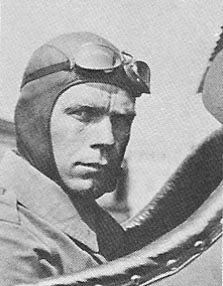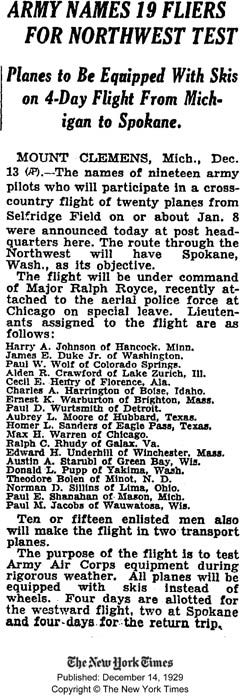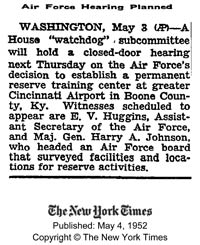Harry A. Johnson, Ca. 1925 (Source: REFERENCES, p. 18)
 |
Harry Johnson landed twice at Tucson, first on Wednesday March 30, 1927. Based at Dayton, OH, he and a single passenger, a "Mr. Ryan," (T. Claude Ryan?) were east bound from San Diego, CA. They flew in 26-426, a Douglas C-1 transport. They remained overnight at Tucson, departing to Dayton the next morning at 8:20. He wrote in the Remarks column of the Register, "Ferry trip."
His second landing was on Tuesday, March 17, 1931. He was solo in the Boeing P-12-D, 31-252. He appears to have been accompanied by a sister Boeing ship, 31-253, flown by N.B. Harbold. They were based together at Selfridge Field, MI, landed together, and both flew the same itinerary toward the east. Johnson commanded the 94th Pursuit Squadron at Selfridge Field at the time.
Dunkirk (NY) Evening Observer, Friday August 7, 1931 (Source: Woodling)
 |
Interestingly, a day later three additional Boeings, 31-224, 31-226 and 31-225, were landed at Tucson by pilots George Brett, Victor Strahm and S.P. Wright, respectively. They, too, shared the same home base and initial destination as Harbold and Johnson. Given the similar itineraries and the sequential run of airplane numbers, these pilots were clearly ferrying new P-12-Ds from the Boeing factory to Detroit. If you follow Brett's link, you'll find an itinerary plotted on a chart that shows the approximate path of their trip from the Boeing factory back to Michigan. Regardless of the details, all five pilots went on to enjoy prestigious careers with the Army.
Earlier, Johnson participated in the 1925 National Air Tour as the Official Advance Airplane, U.S. Air Service, Wright Field. He flew an unidentified de Havilland DH4 with a Liberty engine. The photo above, left, is from the Tour reference linked in the caption.
The P-12-D, 31-252 ,that Johnson flew through Tucson was destroyed on August 6, 1931 one mile southeast of Selfridge Field, MI. Although the link identifies the airplane, it offers no information as to the identity of the pilot. However, a news article from the Dunkirk (NY) Evening Observer for Friday August 7, 1931 ("THREE ARMY PLANES WRECKED AT SELFRIDGE FIELD") states that Johnson bailed out of an airplane on the day before, so it's likely he was the pilot of 31-252. The article is at right, and Johnson's experience is cited in the next to last paragraph. Four airplanes lost in two days is not a good record. Note that Register pilot N.B. Harbold directed the maneuvers.
Johnson's official Air Force biography is at the link. That biography summarizes his early duties with the Signal Corps during WWI, his transfers to various U.S. and foreign bases, and his progression through the ranks.
He enlisted in the Air Corps in 1917, became an aviation cadet at Love Field, Dallas, TX, and was commissioned in 1918. In 1919 he flew patrol missions along the Texas-Mexico border during operations against Pancho Villa.
The New York Times, December 14, 1929 (Source: NYT)
 |
As an engineer and test pilot, he took part in early high-altitude test flights at what is now Wright-Patterson AFB in Ohio. His NASM biographical folder (cited, left sidebar) contains news articles that describe his test work mostly during February, 1929. For example, the Newark (NJ) Star Eagle of Wednesday, February 13, 1929 describes his flight to 39,000 feet and his discovery of ice crystals that, when his photographer in the back seat removed his glove, his hand was, "...pierced as though by a thousand needles."
At least two other news articles in his NASM file cite attempts at altitude records. One in the Newark (NJ) Ledger of Sunday, February 24, 1929 tells of one attempt that was abandoned because of fog that prevented the flight from going past an hour (instrument flight had not yet been perfected). The New York Sun of Wednesday, February 27, 1929 reported another of his flights reaching an estimated 40,000 feet..
In December, 1929, Johnson was recruited to be part of a nine-day cross-country endeavor to, "... test Army Air Corps equipment during rigorous weather." The article, left, from The New York Times of December 14, 1929 describes the logistics and the commander, Register pilot Ralph Royce.
A nice recap of Army aviation activities during 1929 was written in The New York Times for January 12, 1930. A PDF download of the article (63kb) is at the link. Two altitude records by Johnson are called out, as is the long-distance record of 7,000 miles by Register pilot and then Assistant Secretary of War for Aeronautics F. Trubee Davison.
During WWII Johnson served in Panama and England and was commander of Fort Richardson, AK. The New York TImes of October 31, 1943 reported that he was honored as a commander of the Order of Orange-Nassau with swords from Netherlands Queen Wilhemina. He was one of five American officers honored by the Queen for their aid to the Netherlands Flying School at Jackson, MS. One of the other officers was fellow Register pilot Thadeus V. Foster.
The New York TImes, May 4, 1952 (Source: NYT)
 |
After WWII, he commanded the 10th Air Force from June 18, 1946 to January 6, 1948 and from July 1, 1948 to April 30, 1950. He was promoted to Major General in 1950 during his command of the 10th Air Force. After the war, the 10th Air Force initially conducted air defense operations and training beginning in the late 1940s, then later concentrated on air reserve training throughout the 1950s.
The article, right, from The New York TImes of May 4, 1952, corroborates his focus on training. It was probably one of his last assignments and meetings before he retired.
Johnson retired as Major General in 1953 with more than 36 years service. He was born in Litchfield, MN June 29,1893. He died May 1, 1978 at San Antonio, TX, age 84.
---o0o---
Dossier 2.2.112
THIS PAGE UPLOADED: 05/14/12 REVISED:
|





